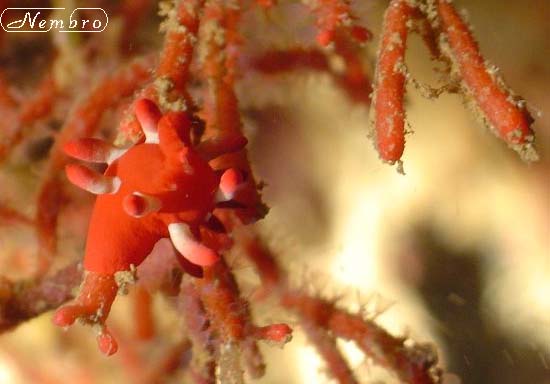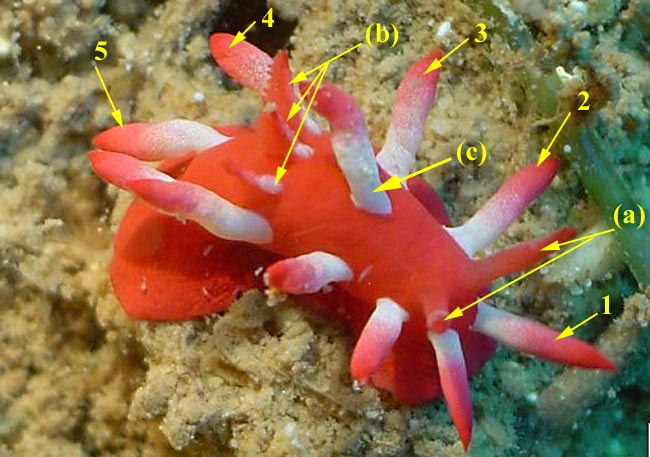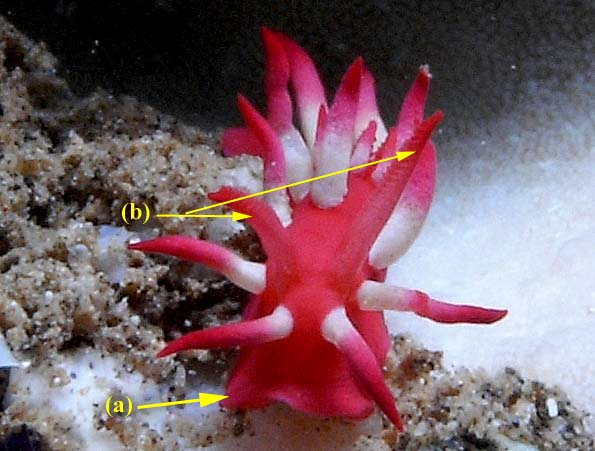This species has been observed Mayotte and Madagascar Islands
Species characteristics : The body is uniformly red with the exceptions of the gill rachises and the base of the notal papillae, which are pinkish white. There are five pairs of elongate notal papillae along the sides of the body. Two of these are situated anterior to the rhinophores. A single medial papilla is present mid-dorsally anterior to the gill The gill consists of 3-4 unipinnate branches. |

|
|
| Showing species characteristics... | Photo Marina Poddubetskaia Mayotte, M'Tsapéré, 8 m, 5 November 2003, size : 10 mm |
|
Remarks :
Identification confirmed by Bill Rudman
Synonymous : (according Worms)
- Hopkinsia nakamotoensis, Hamatani, 2001
Bibliographic data :
The body is elongate and wide. There is no distinct notal border. The foot extends posteriorly and is devoid of notal papillae
The gill lamellae and apices of the notal papillae are the same color as the remainder of the body. The gill consists of 3-4 unipinnate branches.
The rhinophores are elongate with 13-20 congested lamellae.
The anterior end of the foot is rounded and forms a projection anterior to the mouth. The oral tentacles are fused to form an oral veil.
The genital aperture is situated on the right side of the body approximately a third of the length of the body posterior to the head
This species is found on outer reef faces in 10–30 meters of water, where it feeds upon the bright red bryozoan, Tropidozoum cellariiforme Harmer, 1957 (Gosliner, Behrens, and Williams 1996).
This okenia looks like other species of Okenia but :
- In coloration this species closely resembles O. rosacea MacFarland, 1905, and O. hiroi Baba,1938, but O. nakamotoensis has five pairs of lateral appendages and a single mid-dorsal appendage anterior to the gill while O. rosacea and O. hiroi have more numerous randomly distributed notal appendages. Furthermore in these two species, the notal papillae haven't a pinkish white base like in O. nakamotoensis
- It is also very similar in colour to O. kondoi but O. nakamotaensis has a much broader body and bulbous dorsal appendages. It also differs from that species in having 5 pairs of dorso-lateral processes rather then 4 in O. kondoi
- A similar species pair from northern Australia, O. stellata and O. hallucigenia have recently been described (Rudman, 2004) but in these species all the body and the papilla are pink
References :
Bill Rudman Seaslug site : Sea Slug Forum : Okenia nakamotoensis
Nudipixel Okenia nakamotoensis
Publications :
Gosliner, T.M., D. Behrens, and G. Willams. 1996. Coral Reef Animals of the Indo-Pacific . Sea Challengers, Monterey, California. 314 pp., 1103 pls
Gosliner, T. M. (2004) Phylogenetic Systematics of Okenia, Sakishimaia, Hopkinsiella and Hopkinsia (Nudibranchia: Goniodorididae) with descriptions of new species from the tropical Indo-Pacific. Proceedings of the California Academy of Sciences , 55: 125-161
Hamatani, I. (2001) Two new species of Goniodorididae (Opisthobranchia; Nudibranchia) with a new genus from Kuroshima Island, Okinawa, Japan. Venus , 60(3): 151-156
Rudman, W.B. (2004) Further species of the opisthobranch genus Okenia (Nudibranchia: Goniodorididae) from the Indo-West Pacific. Zootaxa , 695: 1-70
Other photos of Okenia nakamotoensis :
Marina Poddubetskaia
This species is found on outer reef faces in 10–30 meters of water, where it feeds upon the bright red bryozoan, Tropidozoum cellariiforme Harmer, 1957 (Gosliner, Behrens, and Williams 1996). |
 |
 |
Marina Poddubetskaia
There are five pairs (1, 2, 3, 4 and 5) of elongate notal papillae along the sides of the body. Two of these are situated anterior to the rhinophores. A single medial papilla ( c) is present mid-dorsally anterior to the gill The gill consists of 3-4 unipinnate branches (b) The rhinophores (a) are elongate with 13-20 congested lamellae. |
Emmanuelle Aigle Mayotte, Mliha, 14 m, 21 March 2010 The anterior end of the foot is rounded and forms a projection anterior to the mouth. The oral tentacles are fused to form an oral veil (a). The rhinophores (b) are elongate with 13-20 congested lamellae. They are the same color as the rest of the body
|
|
 |
Alain-Benoît Rassat
Madagascar, Nosy Bé, 24 January 2004
|
More photos from Indian Ocean
Mayotte, Okenia nakamotoensis a red seaslug, at M'Tsapéré, by Marina Poddubetskaia
Mayotte, Okenia nakamotoensis, seaslugs eating bryozoan, at Handréma, by Marina Poddubetskaia
